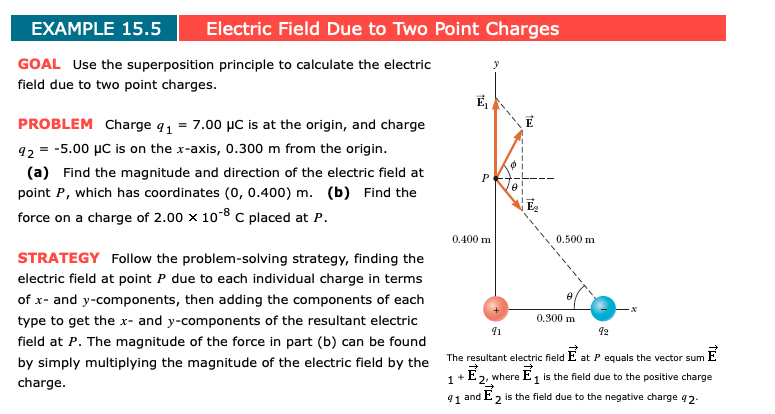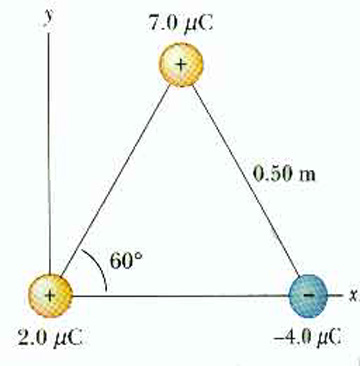Magnitude Of Resultant Electric Field
E 1 kq 1 r 2 1 E 1 is the magnitude of the electric field of charge q 1 at Point P. The Resultant Electric Field.
B3 The Electric Field Due To One Or More Point Charges Physics Libretexts
Representing electric fields ESBPM We can represent the strength and direction of an electric field at a point using electric field lines.

Magnitude of resultant electric field. Obtain the expression for i the magnitude and ii the direction of the resultant electric field at the vertex A due to these two charges. The magnitude of an electric field due to a charge q is given by. Vector sum of the fields due to each charge taken individually.
Calculate the magnitude and direction of the electric field at a point P located at 10 cm from a point charge Q -20 C. The electric field strength at point X due to the 20 x 10-6 was 112 x 106 Vm-1 not sure if this is right at X due to the 40 x 10 -6 was 225 x 106 Vm-1 again these may well be incorrect as i wasnt sure how to calculate the resultant i used. Note that the electric field is defined for a positive test charge q so that the field lines point away from a positive charge and toward a negative chargeSee Figure 2 The electric field strength is exactly proportional to the number of field lines per unit area since the magnitude of the electric field for a point charge is latexEkfracQr2latex and area is proportional to.
Calculate the magnitude and direction of the electric field strength at the midpoint between the charges. K 9 x 109 Nm2C2 1 C 106 C. NIC Base your answer to the following question on the diagram below which represents two large parallel conducting plates charged to a potential of 10.
E is the magnitude of the electric field at a point in space k is the universal Coulomb constant k 899 10 9 N m 2 C 2 q is the charge of the particle that we have been calling the point charge and r is the distance that the point in space at which we want to know E is from the point charge that is causing E. The magnitude of the electric field the Page 5 intensity at P is A 40 10 3 NC 102 NC B 25 C 16 NC D 20. CiCalculate the magnitude of the resultant electric field strength at the mid-point of the line joining the two charges in the diagram above.
The resultant field E. E k q r 2 and it is directed away from charge q if q is positive and towards charge q if q is negative. This is similar to representing magnetic fields around magnets using magnetic field lines as you studied in Grade 10.
E in the vicinity of a number of point charges is equal to the vector sum. What are the magnitude and direction of the resultant electric field at a point that is midway between sheets B and C or 200 cm from each of these two sheets. Calculate the electric field magnitude and direction at the upper right corner of a square 122 m on a side if the other three corners are occupied by 245eqtimes eq10eq-6 eq C.
Enter positive value if the field points in x-direction and negative value if the field. Express your answer in newtons per coulomb. In the following we will study what the electric fields look like around isolated charges.
The plates are separated by a distance of 0050 meter. E is the magnitude of electric field Q is the charge point r is the distance from the point k is the Coulombs constant k 1 4 0 89876 109 N m C. The 40 109 C charge has a mass of 50 104 kg.
Consider E for each charge. Electric field strength _____ unit _____ 4. Calculate the distance from the 80 109 C charge at which the electric field strength is zero.
It states that The total electric field at a point P is the vector sum of the fields at P due to each point charge in the charge distribution. Hence the diagram below showing the direction the fields due to all the three charges. Magnitude of electric field due multiple charges can be calculated using superposition principle.
The vector E1 is raised 369 degrees west of north which would give the components of E1 as follows. Calculate the magnitude of the electrostatic force acting on this charge. Then to solve using unit vectors I drew the components from point P.
The electric field of charge q 1 at Point P depends on the amount of q 1 and 1r 2 where r is the distance from the point charge. Wo point charges q and -2q are placed at the vertices B and C of an equilateral triangle ABC of side a as given in the figure. We may come up with a formula for electric field E as.
State an appropriate unit for your answer. Based on this I expected the magnitude of the resultant electric field to be -17325 V.

Electric Field Lines Multiple Charges Physics

Electric Field 3 Of 3 Calculating The Electric Field In Between Two Charges Youtube

Electric Field Lines Multiple Charges Physics
Example 3 2 Electrostatic Force Between Three Non Colinear Point Charges

Four Point Charges Are At The Corners Of A Square Of Side A As Shown In Figure P15 8 Determine The Youtube

A Place A Charge Of 4 10 c At Point P And Find Chegg Com

Three Point Charges Are Located At The Corners Of An Equilateral Triangle As In Figure P15 13 Find Youtube

The Magnitude And Direction Of Electric Field Problems And Solutions Solved Problems In Basic Physics
Electric Charge And Electric Field
Electric Charge And Electric Field
Electric Force Article Electrostatics Khan Academy

Two Point Charges 410 6c And 210 6c Are Placed At The Vertices A And B Of A Right Angled Triangle Abc Respectively B Is The Right Angle Ac 2 10 2 M And Bc 10 2m Find The

Calculate The Magnitude Of The Electric Field At The Center Of A Square Youtube
Electric Fields Magnitude And Direction Physics Forums






Posting Komentar untuk "Magnitude Of Resultant Electric Field"